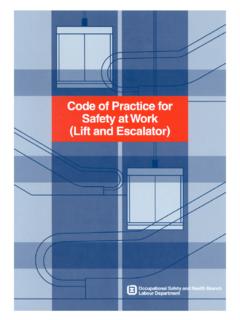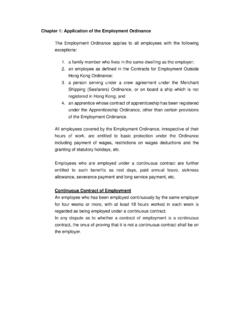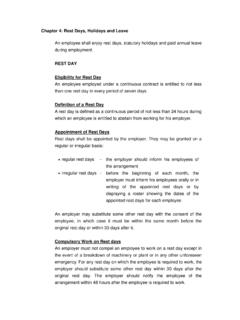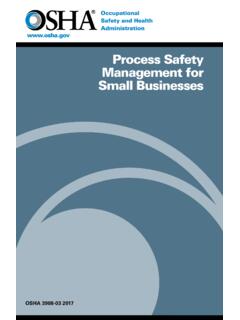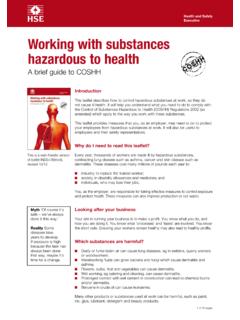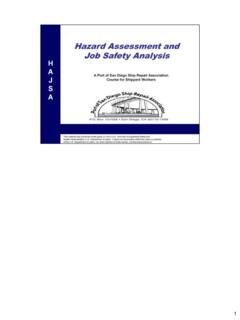Transcription of Safety at Work--A Guide to Ladders and Elevated Working ...
1 Safety at Work A Guide to Ladders and Elevated Working Platforms 4/2008-1-B86aPublished by the Labour Department 10 Safety at Work A Guide to Ladders and Elevated Working PlatformsThis guidebook is published by theOccupational Safety and Health Branch of the Labour DepartmentThis edition April 2008 This guidebook is issued free of charge and can be obtained from the offices of theOccupational Safety and Health Branch of the Labour Department. It can also be downloadedfrom website of the Department at enquiries on addresses and telephone numbers of the offices, please visit the website ofthe Department at or call 2559 guidebook may be freely reproduced except for advertising, endorsement or commercialpurposes. Please acknowledge the source as " Safety at Work - A Guide to Ladders andElevated Working Platforms", published by the Labour at Work A Guide to Ladders and Elevated Working Platforms1 Safety at Work A Guide to Ladders and Elevated Working PlatformsContentsPage(I)Foreword2(II)Lad ders2-5(III) Fixed Access Ladders6(IV) Elevated Working Platforms7-8(V)Enquiry9 Safety at Work A Guide to Ladders and Elevated Working Platforms2 Safety at Work A Guide to Ladders and Elevated Working Platforms(I) ForewordLadders and Elevated Working platforms are common ancillary tools for works at year, a considerable number of workers are injured whilst Working at height.
2 Someare seriously injured or lose their lives. Detailed analysis reveals that the accidents areeither caused by workers not using these ancillary tools or workers fail to use the toolsproperly. In fact, most of the accidents could be avoided. In publishing this guidebook, theLabour Department aims to use plain language and illustrations to introduce to the industriescommon types of Ladders and Elevated Working platforms, their applications and safetymeasures. We hope this guidebook could serve to raise workers' Safety awareness in theuse of Ladders and Elevated Working platforms, thus helping to avoid accidents.(II) LaddersLadders can be classified as portable Ladders and fixed Ladders . There are also straightladders and stepladders. To ensure Safety , we need to consider the following Safety hintsbefore using a ladder:1.
3 Application- What kind of work do you intend to perform using theladder?2. Selection- Which type of ladder do you need?3. Process- Under what circumstances will you work? What safetyprecautions should you take?4. training - Have you received training on the safe use of ladder?Portable platform ladderDifferent types of ladderExtension ladderStraight ladderPlatform ladder with castorsStepladder3 Safety at Work A Guide to Ladders and Elevated Working PlatformsXNote the following points in each of the Safety hints:1. Application Conduct risk assessment at the workplace where a ladder will be used to identify thepotential hazards. ( Is there a danger of electric shock? Is the ladder placed on abusy passageway?) Identify the type and nature of work. Consider the frequency and duration of using the ladder. Be certain about the application of the ladder to be used.
4 Consider using other access equipment that is safer than the Selection Use the ladder in accordance with the manufacturer's instruction is of paramountimportance. Use the right type of ladder and ensure it is structurally sound. You may need to usea straight ladder, a stepladder or other access equipment (such as a mobile ladderscaffold). Choose the ladder that is suitable for the job - do not use the same ladder for all the ladder of appropriate size and made of proper material according to theneeds of work. If fittings or accessories are required, contact the supplier or manufacturer of theladder to find out what kind of fittings or accessories can fit the needs. Under nocircumstances should the structure of the ladder be altered without using the ladder near a door or on a busy at Work A Guide to Ladders and Elevated Working PlatformsSecurely fasten the ladder to avoid the ladder on a 1:4 ratio of setbackdistance to height.
5 The top of the laddershould be 1M above the support the damaged Process Make sure that the footwear is free frommud or grease before climbing up aladder. Ensure that there is sufficient spacebehind the steps to provide a properfooting. Employers should properly instructworkers of the hazards in the workplaceas well as the relevant Safety measuresneeded. Ladder users should read and follow theinformation and instruction provided bythe manufacturer. Pay attention to overhead objects orelectric cables while using the ladder. Properly store and maintain the ladder. Ensure the ladder is stable and restingon an even and solid ground. Fastenthe ladder properly with ropes whenevernecessary, or have a fellow worker tostabilise the ladder with hands. For straight Ladders , the top of the laddershould be at least one metre above theresting place to provide for the ladder should be placed on a 1:4ratio of setback distance to height.
6 The top and bottom of the ladder shouldbe kept free from obstruction. Inspect the ladder before use andregularly afterwards. Use a checklist inconducting inspections. The resultshould be confirmed and signed by theofficer concerned. Inspection and repair of the ladder shouldbe done by competent persons. Damagedladders should be clearly labelled andremoved immediately. Draw up rescue measures to deal withaccidents, including persons falling fromladders or fall of at Work A Guide to Ladders and Elevated Working PlatformsXThe following are common situations of accidents, which should be avoided as far aspossible:Never overstretch the body toeither sides of the training Train the worker on related Safety information,or supervise the worker by the experienced. The training should focus on the equipment tobe used and the work to be performed.
7 The content of training should include:-the proper technique of climbing a climbing up or down a ladder, one mustface the ladder and maintain a three-pointcontact with it; and-both the best practice and the unsafe above points on the safe use of ladder are not exhaustive. Users should work out othersafety measures according to their own needs to suit their Working procedures the ladder and maintain a three-pointcontact when moving up and down. never carry heavy objects when climbing up ordown a ladder. Tools or materials can be liftedby rope to the workplace or raised by somebodyelse. Light tools or materials can be carried in aholster attached to a belt or in a tool bag; never use makeshifts, such as chairs, cylindersor boxes, to replace the ladder; never join short Ladders together to form longones; never overstretch the body to either side of theladder.
8 Instead, one should position the ladderat the location where work is to be performed; never try to straighten or use any ladder that isalready bent; never paint the wooden ladder since the paint maycover up cracks and defects in the ladder; and never overload the ladder. Under normalcircumstances, only one person is allowed towork from a : For works at a height of more than 2 metres, Ladders should onlybe used for access and egress, but not as a tool to work at Work A Guide to Ladders and Elevated Working Platforms(III) Fixed Access LaddersFixed access Ladders are widely used as means of access to and egress from tower cranes,overhead structures in construction works ( flyovers), water tanks in buildings, liftmachine rooms, shafts, etc. For fixed access Ladders reaching a height of 3 metres or more,the following points should be noted: suitable Safety hoops should beinstalled; the spacing of the Safety hoopsshould not exceed one metre; the lowest Safety hoop should beinstalled at a height not exceeding 3metres above the ground; the highest Safety hoop should beinstalled one metre above the upperend of access and egress.
9 If it is aworking platform, the hoop shouldbe connected to the guard-rail of theplatform; and there should be a suitable landingplace or rest platform at an intervalof not greater than 9 metres alongthe fixed access ladder. The landingplace or rest platform should befitted with suitable guard-rails ofadequate strength. The height of thetop guard-rail should be between900 and 1,150 mm while the heightof the intermediate guard-rail shouldbe between 450 and 600 mm. Thetoe-board installed should be of atleast 200 mm high. Fixed access ladder6 Safety at Work A Guide to Ladders and Elevated Working Platforms7 Safety at Work A Guide to Ladders and Elevated Working Platforms(IV) Elevated Working PlatformsThe use of Elevated Working platforms is increasingly popular. They are widely used tocarry workers for works at height, such as maintenance of ceilings and cleaning the externalwall of are many different designs of Elevated Working platforms.
10 Each type of workingplatform has its own application. When choosing a suitable Elevated Working platform, thefollowing points should be taken into consideration: type and size of the platform required; the loading capacity, height of elevation, mobility andstability; the conditions and restrictions on the road or at the placewhere the platform is set up, whether there are trafficlanes nearby; the distance to be kept between the platform and the nearbyobject (such as building); passageway for safe access to and egress from the platform; type and nature of the material to be carried; and whether the manufacturer or the agent provides trainingcourses on maintenance and operations of the types of Elevated Working platforms7 Safety at Work A Guide to Ladders and Elevated Working Platforms8 Safety at Work A Guide to Ladders and Elevated Working PlatformsNote the following points when using the Elevated Working platform: inspect the platform thoroughly every time before use; ensure the load to be carried does not exceed the maximum safe Working load asspecified by the manufacturer; rest the Elevated Working platform on an even and solid ground; extend the outriggers of the Elevated Working platform fully if the Working platformhas such provision; ensure the Elevated Working platform is kept at a safe distance from overhead cables.
